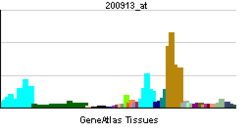PPM1G
Protein phosphatase 1G is an enzyme that in humans is encoded by the PPM1G gene.[3][4]
The protein encoded by this gene is a member of the PP2C family of Ser/Thr protein phosphatases. PP2C family members are known to be negative regulators of cell stress response pathways. This phosphatase is found to be responsible for the dephosphorylation of Pre-mRNA splicing factors, which is important for the formation of functional spliceosome. Studies of a similar gene in mice suggested a role of this phosphatase in regulating cell cycle progression. Alternatively spliced transcript variants encoding the same protein have been described.[4]
References
Further reading
- Guthridge MA, Bellosta P, Tavoloni N, Basilico C (1997). "FIN13, a novel growth factor-inducible serine-threonine phosphatase which can inhibit cell cycle progression". Mol. Cell. Biol. 17 (9): 5485–98. PMC 232397
 . PMID 9271424.
. PMID 9271424.
- Murray MV, Kobayashi R, Krainer AR (1999). "The type 2C Ser/Thr phosphatase PP2Cgamma is a pre-mRNA splicing factor". Genes Dev. 13 (1): 87–97. doi:10.1101/gad.13.1.87. PMC 316367
 . PMID 9887102.
. PMID 9887102.
- Strausberg RL, Feingold EA, Grouse LH, et al. (2003). "Generation and initial analysis of more than 15,000 full-length human and mouse cDNA sequences". Proc. Natl. Acad. Sci. U.S.A. 99 (26): 16899–903. doi:10.1073/pnas.242603899. PMC 139241
 . PMID 12477932.
. PMID 12477932.
- Flajolet M, Rakhilin S, Wang H, et al. (2004). "Protein phosphatase 2C binds selectively to and dephosphorylates metabotropic glutamate receptor 3". Proc. Natl. Acad. Sci. U.S.A. 100 (26): 16006–11. doi:10.1073/pnas.2136600100. PMC 307683
 . PMID 14663150.
. PMID 14663150.
- Gerhard DS, Wagner L, Feingold EA, et al. (2004). "The status, quality, and expansion of the NIH full-length cDNA project: the Mammalian Gene Collection (MGC)". Genome Res. 14 (10B): 2121–7. doi:10.1101/gr.2596504. PMC 528928
 . PMID 15489334.
. PMID 15489334.
- Maynes JT, Luu HA, Cherney MM, et al. (2006). "Crystal structures of protein phosphatase-1 bound to motuporin and dihydromicrocystin-LA: elucidation of the mechanism of enzyme inhibition by cyanobacterial toxins". J. Mol. Biol. 356 (1): 111–20. doi:10.1016/j.jmb.2005.11.019. PMID 16343532.
- Suh EJ, Kim TY, Kim SH (2007). "PP2Cgamma-mediated S-phase accumulation induced by the proteasome-dependent degradation of p21(WAF1/CIP1)". FEBS Lett. 580 (26): 6100–4. doi:10.1016/j.febslet.2006.10.005. PMID 17054950.
- Kimura H, Takizawa N, Allemand E, et al. (2006). "A novel histone exchange factor, protein phosphatase 2Cgamma, mediates the exchange and dephosphorylation of H2A-H2B". J. Cell Biol. 175 (3): 389–400. doi:10.1083/jcb.200608001. PMC 2064517
 . PMID 17074886.
. PMID 17074886.
- Luo W, Peterson A, Garcia BA, et al. (2007). "Protein phosphatase 1 regulates assembly and function of the beta-catenin degradation complex". EMBO J. 26 (6): 1511–21. doi:10.1038/sj.emboj.7601607. PMC 1829374
 . PMID 17318175.
. PMID 17318175.
- Allemand E, Hastings ML, Murray MV, et al. (2007). "Alternative splicing regulation by interaction of phosphatase PP2Cgamma with nucleic acid-binding protein YB-1". Nat. Struct. Mol. Biol. 14 (7): 630–8. doi:10.1038/nsmb1257. PMID 17572683.
- Petri S, Grimmler M, Over S, et al. (2007). "Dephosphorylation of survival motor neurons (SMN) by PPM1G/PP2Cgamma governs Cajal body localization and stability of the SMN complex". J. Cell Biol. 179 (3): 451–65. doi:10.1083/jcb.200704163. PMC 2064792
 . PMID 17984321.
. PMID 17984321.

 . PMID 9271424.
. PMID 9271424. . PMID 9887102.
. PMID 9887102. . PMID 12477932.
. PMID 12477932. . PMID 14663150.
. PMID 14663150. . PMID 15489334.
. PMID 15489334. . PMID 17074886.
. PMID 17074886. . PMID 17318175.
. PMID 17318175. . PMID 17984321.
. PMID 17984321.